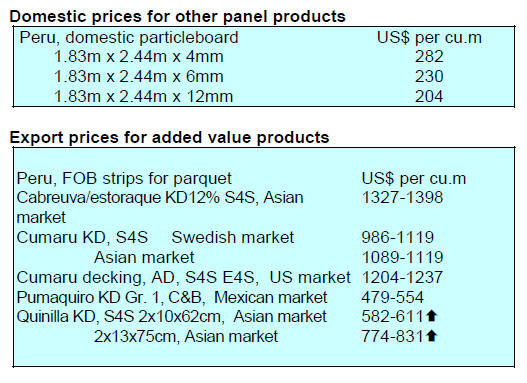4.
INDONESIA
Hard work delivers first half
successes
The Indonesian forestry sector has achieved two major
goals in the first half of the year; a significant fall in the
number of hotspots that could have resulted in forest fires
and a substantial growth in wood product exports.
The Environment and Forestry Minister, Siti Nurbaya, said
these successes have been achieved through hard work
amidst the increasingly widespread pandemic.
The Minister reported that there has been a decline in the
number of hotspots detected by the Terra/Aqua satellite
system (LAPAN). She also pointed out the solid progress
in exports in the first half of the year when a 20% year on
year increase was recorded.
She added - looking at our forestry export growth the first
thing that crosses my mind is that companies have done so
much to avoid laying-off workers and that is
commendable.
See:
https://foresthints.news/indonesian-forestry-sector-deliverstwo-major-points-of-progress-in-first-half-of-2021
Furniture and handicraft exports surge
In the first 4 months of this year Indonesia’s exports of
wooden furniture and handicrafts increased by almost 40%
compared to the same period in 2020.
Abdul Sobur, Chairman of the Presidium of the Indonesian
Furniture and Craft Industry Association (HIMKI),
anticipates that this year exports could rise to US$2.75-3
billion. He added that the furniture and craft sectors are
important industries and have been pillars of the economy
during the current pandemic.
The sectors absorbs a lot of labour so it is good that the
furniture and craft industries have survived, generated
foreign exchange and supported the workforce force, he
added.
In related news, exports of Indonesian handicrafts to Japan
reached US$10.32 million in the first 5 months of 2021, an
encouraging figure amid the pandemic as most are from
SMEs. Products exported to Japan included wooden
frames valued at US$2.18 million, rattan baskets worth
US$562,000, woven baskets made from natural material
US$435,000 thousand and synthetic wigs worth
US$423,000.
See:https://pressrelease.kontan.co.id/release/beri-angin-segarekspor-produk-kerajinan-ke-jepang-tembus-usd-1032-juta?page=all
Exploring potential for wood biomass trade with Japan
Indonesian forestry sector operators are considering
cooperating with companies in Japan in the utilisation of
wood biomass. Indonesian Ambassador to Japan, Heri
Akhmadi, has said Indonesia has a large biomass potential
while Japan has the technology to utilise biomass so there
are opportunities for both sides.
He explained that Sumitomo Forestry in Japan already has
an urban biomass power generation plant in Kawasaki.
Meanwhile, Mitsubishi owns and develops biomass cofiring
technology. Renova Inc. and Kyudenko Corporation
own biomass power plants and may be interested in
building biomass power plants in Indonesia.
Chairman of the Indonesian Forestry Community
Communication Forum (FKMPI), Indroyono Soesilo,
stated that the potential for developing biomass from
energy plantations in Indonesia is large.
See:
https://www.medcom.id/ekonomi/bisnis/ObzVdZ0b-industrikayu-indonesia-diharap-gandeng-jepang-gali-potensi-biomassakayu
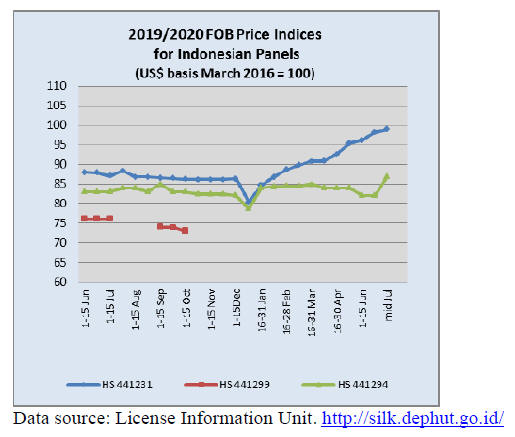
5.
MYANMAR
4,320 new corona cases with 64 deaths
on 9 July
The Myanmar Ministry of Health and Sports confirmed
4,320 new COVID-19 cases on July 9 bringing the total
number of patients identified to 184,375. Some health
experts say Myanmar's real rate of infection is likely to be
far higher given a collapse in testing since the military
takeover and because health workers joined strikes to
protest.
Hospitals and COVID-19 centers in Myanmar are
overwhelmed and turning away patients in some areas,
including Yangon. The main problem is oxygen supplies
and some towns are experiencing shortages. Myanmar's
military rulers have indicated Russia will supply two
million doses of coronavirus vaccines.
Chinese authorities locked down a city bordering
Myanmar shutting most businesses and requiring residents
to stay at home as a fresh outbreak of COVID-19
expanded.
See:
https://www.irrawaddy.com/news/burma/myanmarhospitals-run-out-of-beds-amid-covid-19-surge.html
Growing risk of economic instability
According to U Ye Min Aung, Chairman of the Myanmar
Rice Federation and Vice-chair of Union of Myanmar
Federation of Chambers of Commerce and Industry, this is
a challenging time for all sectors of the economy. The
domestic media report U Ye Min Aung as mentioning the
biggest challenge for enterprises is banking and finance as
they face many problems with transactions.
Other challenges include security, transportation and
logistics. The biggest challenge for exporters is the rising
cost of transport and international shipping. He called on
the military regime to quickly adopt sound economic
policies and plans.
See:
https://www.frontiermyanmar.net/en/if-theres-no-recoveryall-businesses-will-be-in-trouble/
Navigating trade sanctions
Exporters as well as importers are facing a difficult time
trying to navigate the sanctions that have been imposed by
some major importing countries. The Trade Departmentin
the Ministry of Commerce is now issuing export licenses
for sawnwood but shippers are unsure on the application
of the sanctions asking, do they apply to products milled
from logs purchased before the date of the sanctions, the
date the Trade Department issued the export license or the
date of documents from the Myanmr Timber Enterprise?
The EU and the UK government have provided guidance
notes which can be found at:
See:
https://ec.europa.eu/info/files/guidance-noteimplementation-council-regulation-eu-no-401-2013-myanmarburma_en
and
https://www.gov.uk/government/publications/overseas-businessrisk-myanmar-burma/overseas-business-risk-myanmar-burma
Myanmar Witness secures UK funding for new task
force
A new task force has been launched to investigate
evidence of human rights violations in Myanmar, the
British-government funded project, Myanmar Witness.
The Centre for Information Resilience (CIR), an
independent, non-profit social enterprise, is undertaking
the project.
See:
https://www.reuters.com/world/asia-pacific/myanmarrights-violations-under-scrutiny-new-task-force-2021-07-05/
US Treasury sanctions officials and family members
connected to Myanmar military
The Treasury press release says the following:
Among the 22 individuals sanctioned are seven key
members of Burma’s military which continues to repress
the pro-democracy movement in the country and use lethal
force against the people of Burma, including children and
members of ethnic minority groups.
The other 15 individuals are the spouses or adult children
of previously designated senior Burmese military officials
whose financial networks have contributed to military
officials’ ill-gotten gains.
The Treasury’s Office of Foreign Assets Control (OFAC)
OFAC designated all these individuals pursuant to
Executive Order (E.O.) 14014, “Blocking Property with
Respect to the Situation in Burma.” These sanctions are
not directed at the people of Burma.
See:
https://home.treasury.gov/news/press-releases/jy0260
EITI Board temporarily suspends Myanmar
The EITI Board has expressed its strong concern about the
safety of members of the multi-stakeholder group in the
country and concluded it is not possible to envisage the
EITI operating under the current circumstances.
Consequently EITI has suspended Myanmar temporarily.
The EITI Board indicated it will monitor the situation and
consider if further action is necessary including the
possibility of delisting. Myanmar EITI has issued four
volumes of ‘Forestry Sector Reports’.
See:
https://eiti.org/board-decision/2021-05
6. INDIA
Title
A review of ultra-high frequency data such as power
consumption and vehicle sales provides a clear indication
that economic growth is beginning to recover after the
lockdown-induced collapse in May. Restrictions people’s
movement and on businesses are gradually being eased.
Early data suggests the economic damage from the
current lockdown has been less severe than during the
2020 lockdown.
According to the National Council of Applied Economic
Research (NCAER) the economy is likely to grow 8.4-
10% in the current fiscal year as against a contraction of
7.3% in the previous fiscal year.
See:
https://www.livemint.com/news/india/across-indian-stateseconomic-activity-picked-up-in-june-11625551636249.html
Exports surge
Union minister Piyush Goyal said it is the highest ever
merchandise exports in a quarter in the history of the
nation.
India’s exports during the April to June quarter in 2021
jumped toUS$95 billion this, according to the Minister
was because of growth in the engineering, rice, oil meal
and marine products sectors.
The Minister said that merchandise exports were worth
$82 billion in the second quarter (April-June 2018-19) and
US$90 billion during the last quarter of 2020-21.
Real estate developers experience project delays -
sector seeks urgent relief
The Confederation of Real Estate Developers'
Associations of India released findings of its first ever
industry survey conducted across North, East, West and
South zones between 24th May and 3rd June, 2021, to
assess the impact of second wave of COVID-19 on real
estate sector in India.
A total of 4,813 developers from 217 cities across India
participated in one of the most extensive real estate
surveys conducted during the pandemic. It was found that
90% of developers feel that the second wave is more
devastating on the business than the first.
Labour shortage, financial constraints, approval delays,
increased construction costs and weak customer demand
are key challenges highlighted by the developers.
The survey also spotlights changing consumer behaviour
which has resulted in slower demand and fewer enquires
and site visits.
A staggering 98% developers are facing reduced customer
enquiries and 42% developers are experiencing a 75%
decline in customer enquiries. Furthermore, the report
reveals that the second wave has caused 95% of customers
to postpone their purchase decisions.
Mr. Harsh Vardhan Patodia, President, CREDAI “We
have made a representation to the government citing the
current survey and requesting the government to infuse
urgent financial stimulus and initiate quick progressive
measures to assist recovery.
See:
https://www.credai.org/media/view-details/220
Plantation teak prices C&F Indian ports
Teak logs and sawnwood shipments to India from multiple
sources are recovering. Landed prices are impacted by the
exceptionally high freight costs.
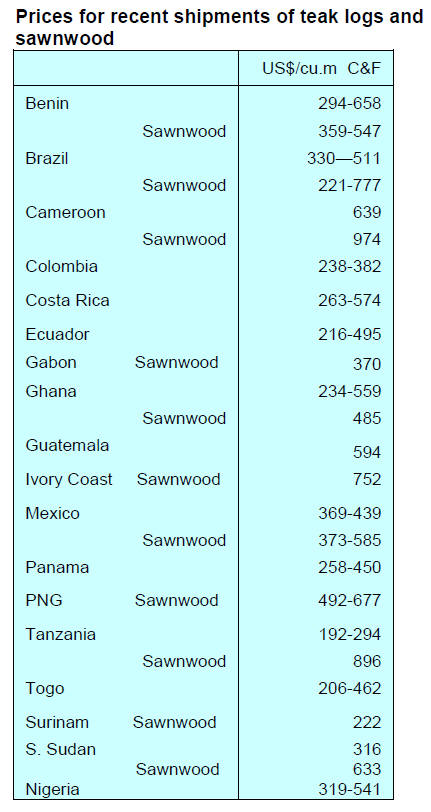

Plywood
The recently increased prices are holding but with log and
veneer prices rising manufacturers are looking for an
opportunity to raise panel prices but this will depend on
how quickly the construction and housing markets
recover.

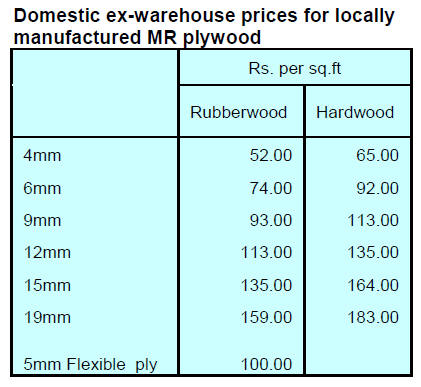
7.
VIETNAM
Vietnam’s forestry and timber industry – solid growth
in the first 6 months
According to Vietnam Forestry Administration
(VNFOREST) in the first 6 months of 2021 about 658
million seedlings of all planting species have been
propagated to meet the national planting target defined for
2021.
To-date the area of newly planted forest is 108,258
hectares or 41.6% of the year plan and over 20% up on the
first half of last year. In particular, under the project ‘plant
1 billion trees’ over 48.5 million trees have been planted.
By the middle of 2021 sustainable forest management
certificates had been granted over 306,726 ha of forest
(including both FSC and VFCS/PEFC certificate schemes)
of which the forest area certified by the VFCS (Vietnam
Forest Certificate Scheme) is 55,002 ha.
In the first half of the year the volume of timber harvested
from domestic forests is 6.8 million cu.m, equal to 32% of
the year plan and 114% over the same period in 2020.
The export value of wooden and non-wood forest products
in the first 6 months of 2021 amounted to US$8.71 billion,
up 62% over the same period in 2020 and included wood
products US$6.35 billion, up 75% and non-wood forest
products US$0.6 billion, up 73%.
It is forecast that in 2021 the export earnings from W&WP
and non-wood forest products will be around US$15.5 –
16.0 billion, a year-on-year growth of between 17 - 20%.
Imports of W&WP in the first 6 months of 2021 were
valued at US$1.54 billion, up 39% over the same period of
last year when imports of wood raw materials was
US$1.15 billion.
In the first half of 2021 government income from the
payment for forest ecosystem service (PFES) increased by
67% over the same period of 2020. VND 1,431.7 billion
(about US$65 million) was collected through PFES.
Most of this money is distributed to upland dwellers as
payment for their contribution to catchment/watershed
forest protection.
See:
http://tongcuclamnghiep.gov.vn/LamNghiep/Index/nganhlam-nghiep-tang-truong-toan-dien-trong-6-thang-dau-nam-4387
Made-in-Vietnam wood products a success in US
market
Vietnam has overtaken China as the largest exporter of
wooden furniture to the US according to the US-based
Furniture Today website. Despite the trade disruptions the
country shipped over US$7.4 billion worth of furniture to
the US in 2020, up 31% compared to 2019. China’s
exports of wooden furniture were valued at US$7.33
billionin 2020.
While the gap is relatively small, Vietnam’s position in
global markets illustrates how the industry in Vietnam has
grown in importance over the years.
Julie Hundersmarck, a Programme Specialist at the US
Forest Service said that the US market is opening to
Vietnamese furniture exporters adding that the authorities
in the US have deployed various tools to ensure exporters
comply with legal timber rules.
Experts commented that Vietnamese exporters need to
prevent origin fraud, since the US is a large and strict
market in terms of trade fraud and tax evasion.
See:
https://en.vietnamplus.vn/madeinvietnam-wooden-productsconquer-us-market/202085.vnp
Vietnam, the second largest exporter of woodpellets
After the US, Vietnam has become the second largest
producer of woodpelletss. In 2020 Vietnam exported 3.2
million tonnes of woodpellets mostly to Japan and Korea
for power generation. In the period from 2013-2020,
exports increased more than 18.2 times from about 175.5
tonnes to 3.2 million tonnes; export value increased more
than 15.3 times, from nearly $23 million to $351 million.
EU, Japan and South Korea are the top consumers of this
wooden product.
The decline in export prices for pellets may be partly due
to the increasing number of enterprises involved in
production. General Department of Customs data shows
that in 2020 there were 74 enterprises participating in
export, up slightly from 72 enterprises in 2018.
In 2020 the number of large-scale exporters (export
volume over 50,000 tonnes/enterprise) was 17, equivalent
to over 23%. The number of medium-sized enterprises
(export volume from 20,000 - 49,000 tonnes/enterprise)
was 10 accounting for 13.5%, the balance were small
enterprises (less than 20,000 tonnes/enterprise).
According to VIFOREST, Vietnam currently maintains 74
woodplellet factories with the total production capacity of
about 4.5 million tonnes per year.
At present the raw materials used by these factories are
mostly wood waste collected from a large number
sawmills, veneer plants and and furniture factories.
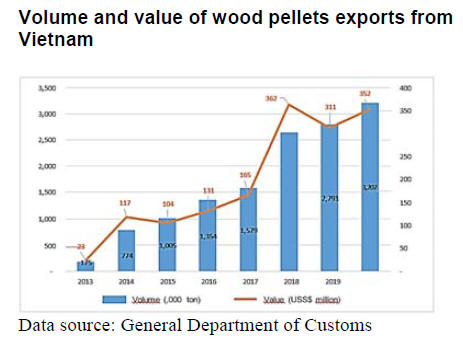
Woodpellet price
The graphic below shows the fluctuations in woodpellet
prices between 2013 and 2020. In 2013, when Vietnam
started woodpellet production and export, price of this
product was US$131/tonne. The price of woodpellets
surged in 2014, dropped down bellow US$100 in 2016,
recovered to U$137 in 2018 and stood at US$111/tonne
over the past 2 years.
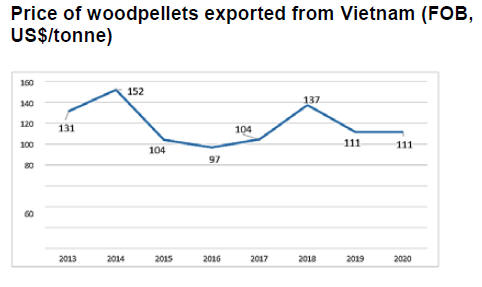
8. BRAZIL
Draft Bill aims to create a price for
forest conservation
The Commission for Economic Development, Industry
and Commerce presented a draft Bill (528/2021) which
proposes regulation of the Brazilian carbon market. This
comes twelve years after the Climate Change Policy was
enacted. At the core of the Bill is the proposal to create a
value for forest conservation and create a legal framework
that brings legal security to investments and remuneration
for environmental services.
The draft Bill will be discussed at the Environment
Commission which will undertake a public hearing
process. It is anticipated that the draft Bill will be carried
to UN Climate Change Conference of the Parties (COP26)
in November.
‘Verde Brazil’ operation continues in the Amazon
The Federal Government issued a Guarantee of Law and
Order decree which authorises the use of the military in
combating environmental crimes in the Amazon.
The period covered by the latest Decree extends
operations for just a short period (28 June to 31 August)
this year.
According to the National Council for the Amazon the
cost of the operation is estimated at R$50 million. During
the operation the military will work in specific
municipalities that are high rates of illegal deforestation
and forest fires. The Decree also establishes that the
actions of the military will be carried out exclusively in
public areas such as indigenous lands, Federal protection
areas among others.
Since 2019 two military operations have been authorised
in the Amazon called the Operation “Verde Brazil (Green
Brazil) 1” and “Verde Brazil 2”. The most recent ended in
April this year.
Brazilian exports face higher than average import
tariffs
A study prepared by the National Confederation of
Industry (CNI) shows that Brazilian exports are subject to
import tariffs that, on average, are much higher than those
faced in most neighboring countries orr countries with
geographic and economic characteristics similar to those
of Brazil.
The average import tariff applied to Brazilian products
abroad is 4.6% while the average of the other countries
analysed in the study is 2.3%. Among the 18 countries
selected by the study Brazil is the one that is subject to the
third highest import tariff (4.6%) when exporting its
products.
The country is only behind Argentina (5.3%) and India
(4.8%). In Latin America, with the exception of Argentina
and Brazil, other countries stand out for the low average
tariff they face in international markets:

The study also shows that, considering only
industrial
products, Brazil faces the fourth highest tariff (3.3%).
among the selected countries.
One factors that contributes to Brazil facing high import
tariffs among the selected countries is the fact that Brazil
has few preferential trade agreements. Currently, the
countries with which Brazil has an agreement represent
only 7% of world trade. The report suggests the country
needs to work to secure bilateral or multilateral trade
agreements to lower tariff barriers faced by exporters.
Dry ports can raise efficiency for timber exports
With an estimated area of 3.7 million hectares of forest
under sustainable management the state of Mato Grosso
continues to be one of the largest timber producers in the
country. However, excessive bureaucracy hinders exports
of products from processing legally harvested wood.
In order to reverse this and encourage sustainable
production the accreditation of dry ports for clearing
wood shipments in Mato Grosso has been proposed to the
Brazilian Institute of the Environment and Renewable
Natural Resources (IBAMA).
A dry port (sometimes referred to as an inland port) is an
inland terminal with good access to a sea port. Dry ports may
also include facilities for storage and consolidation of goods and
Customs clearance services. The location of these facilities at a
dry port relieves competition for storage and Customs space at
the seaport.
The proposal highlights the numerous problems faced by
the timber sector in exporting wood products from natural
forests. The proposal also highlights the need for a quick,
legal and effective flow of forest-based products destined
to overseas markets.
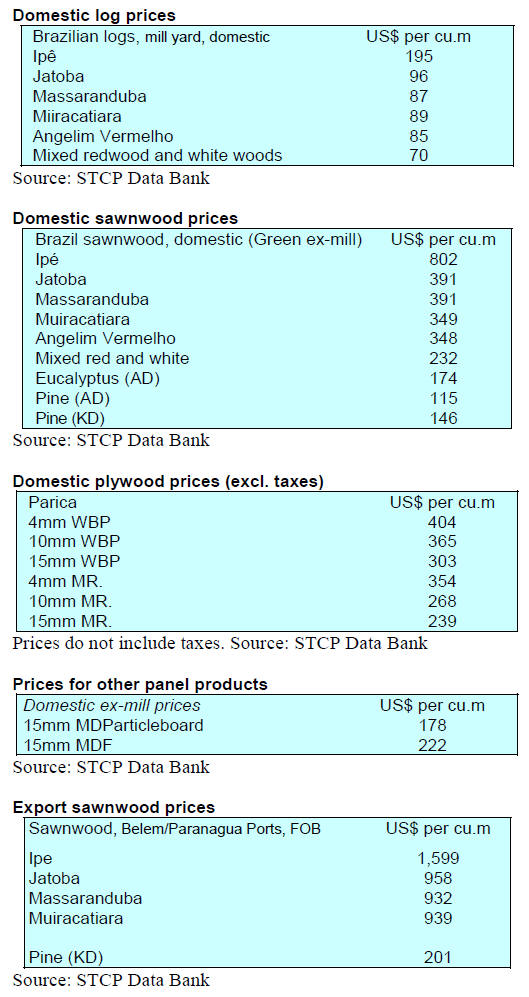
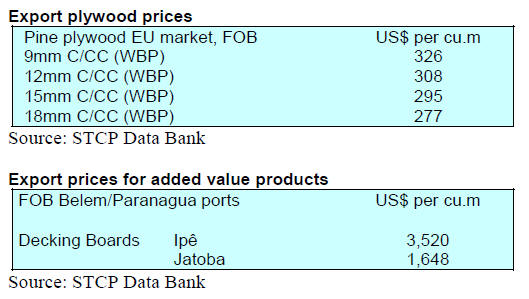
9. PERU
Wood product exports rise over 60%
According to the Association of Exporters (ADEX) in the
first 5 months of this year wood product exports amounted
to US$48.9 million FOB, a vastly different situation
during the same time in 2020 when exports were just
US$29.3 million.
As of May 2021 semi-manufactured products accounted
for over 60% of exports, up over 80% year on year
followed by sawnwood exports which were higher by 28%
year on year. Exports of furniture and parts remain small
as do exports of veneers and plywood.
Of the US$48.9 million exported during the first 5 months
of 2021 China was the main export destination accounting
for an almost 35% which was higher than the share in the
first 5 months of 2020.
France was the second largest market with a share of 17%.
This was much higher than in the same period in 2020.
The United States and Mexico are the third and fourth
placed export destinations. Exports to the US more than
doubled year on yearin the first 5 months of this year but
there was only a modest rise in exports to Mexico.
Sawnwood exports between January and May this year
went mainly to China (37% of sawnwood exports), the
Dominican Republic (18% and up 23%) and Vietnam
(13%, a 200% rise year on year).
Exports to Ecuador accounted for just under 10% of all
sawnwood exports but were very much higher year on
year.
Strategy to combat illegal logging and trade
The Government has approved the "National Multisectoral
Strategy to Fight Illegal Logging 2021 - 2025".
The strategy was approved by Supreme Decree No. 013-
2021-Midagri, signed by the President, Francisco Sagasti,
and nine Ministers of State.
The aim of this is to combat the trade in illegal timber as
well as the protection of the rights of people involved in
the sustainable use, conservation and protection of forests
with special emphasis on communities and indigenous
people.
A permanent Multi-sectoral Commission to Fight Illegal
Logging (CMPLTI) will be responsible for the
implementation and management of activities to support
this strategy. The new strategy covers not only the illegal
logging but also the trade in products of illegal origin as
well as the prevention of crimes such as forced or child
labour.
See:
https://agraria.pe/noticias/gobierno-aprueba-estrategianacional-multisectorial-de-lucha-24811

